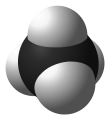Methane
simplest organic molecule with one carbon atom and four hydrogen
Methane is an organic compound with the chemical formula CH
4. It is an alkane with one carbon atom. It is often found as the main part of natural gas. Methane is a greenhouse gas[5][6] 23 times more effective than carbon dioxide. It is also less stable and slowly oxidates by oxygen to carbon dioxide and water.
| |||
| Names | |||
|---|---|---|---|
| Preferred IUPAC name Methane[1] | |||
| Systematic IUPAC name Carbane (never recommended[1]) | |||
Other names
| |||
| Identifiers | |||
3D model (JSmol) | |||
| 3DMet | |||
| Beilstein Reference | 1718732 | ||
| ChEBI | |||
| ChEMBL | |||
| ChemSpider | |||
| ECHA InfoCard | 100.000.739 | ||
| EC Number |
| ||
| Gmelin Reference | 59 | ||
| KEGG | |||
| MeSH | Methane | ||
PubChem CID | |||
| RTECS number |
| ||
| UN number | 1971 | ||
CompTox Dashboard (EPA) | |||
SMILES
| |||
| Properties | |||
| CH4 | |||
| Molar mass | 16.04 g·mol−1 | ||
| Appearance | Colorless gas | ||
| Odor | Odorless | ||
| Density |
| ||
| Melting point | −182.5 °C; −296.4 °F; 90.7 K | ||
| Boiling point | −161.50 °C; −258.70 °F; 111.65 K[3] | ||
| 22.7 mg·L−1 | |||
| Solubility | Soluble in ethanol, diethyl ether, benzene, toluene, methanol, acetone and insoluble in water | ||
| log P | 1.09 | ||
| kH | 14 nmol·Pa−1·kg−1 | ||
| Conjugate acid | Methanium | ||
| Conjugate base | Methyl anion | ||
| −12.2×10−6 cm3·mol−1 | |||
| Structure | |||
| Td | |||
| Tetrahedron | |||
| 0 D | |||
| Thermochemistry | |||
| Std enthalpy of formation ΔfH | −74.87 kJ·mol−1 | ||
| Std enthalpy of combustion ΔcH | −891.1 to −890.3 kJ·mol−1 | ||
| Standard molar entropy S | 186.25 J·(K·mol)−1 | ||
| Specific heat capacity, C | 35.69 J·(K·mol)−1 | ||
| Hazards | |||
| NFPA 704 | |||
| Explosive limits | 4.4–17% | ||
Except where otherwise noted, data are given for materials in their standard state (at 25 °C [77 °F], 100 kPa). | |||
| Infobox references | |||
Uses
Methane is used in gas taps in places such as kitchens, chemistry classrooms, laboratories, etc. as it burns very easily because of its simple molecular structure.
Molecular structure
Methane's molecular structure is very simple. It is a single carbon atom surrounded by four hydrogen atoms.
Production
Methane can be made by many chemical ways, but usually is found in natural gas and is obtained by fractional distillation, after it has become liquid.
References

Wikimedia Commons has media related to Methane.
🔥 Top keywords: Main PageSpecial:Search0Slash (punctuation)BlackSpecial:RecentChanges4 (number)DavidSOLID (object-oriented design)Wikipedia:AboutFile:Sexual intercourse with internal ejaculation.webmHelp:ContentsHelp:IntroductionLisa Sparxxx2023 UEFA Champions League FinalColour24-hour clockAdolf Hitler UunonaBismillahir Rahmanir Raheem6 (number)T. N. SeshanFile:ASCII-Table-wide.svg20 (number)Poor Things (movie)United StatesCristiano RonaldoList of people who have walked on the MoonAli Malikov50 (number)17 (number)The Valley (2024 TV series)GrassList of mathematical symbolsList of U.S. states and territories by time zone8 (number)List of countries by areaWikipedia:Simple talkList of largest Hindu templesRama


